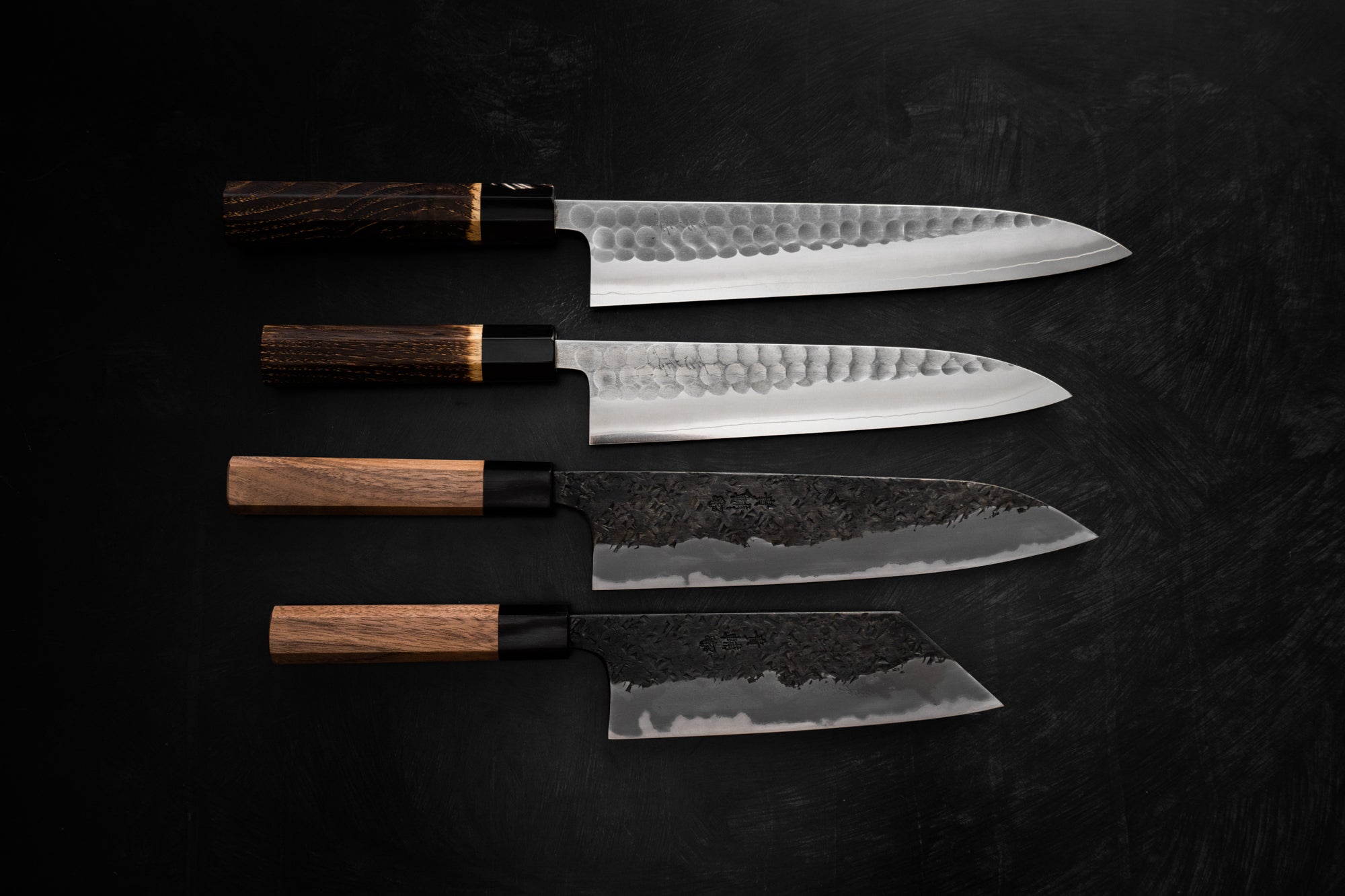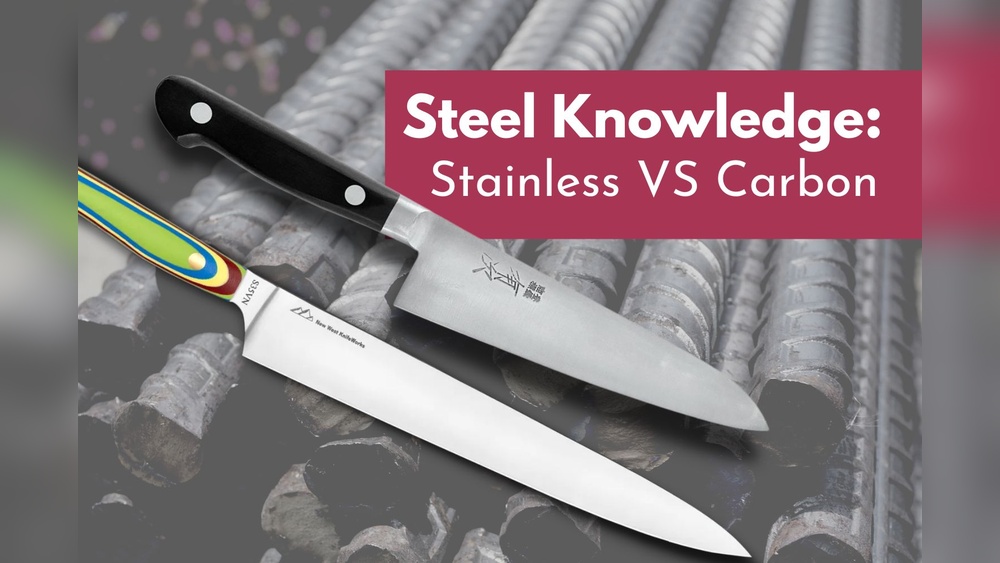Choosing the right knife can make a huge difference in your kitchen. When you’re faced with the choice between a stainless steel knife and a carbon steel knife, it’s easy to feel confused.
Which one will hold its edge longer? Which is easier to care for? And which will give you the best cutting experience? By the end of this article, you’ll know exactly which knife suits your needs and why. Ready to find the perfect blade for your cooking style?
Let’s dive in.
Material Composition
Material composition plays a key role in the performance of knives. It determines strength, sharpness, and durability. Understanding the elements in stainless steel and carbon steel helps you choose the right knife for your needs.
Elements In Stainless Steel
Stainless steel contains iron, carbon, and chromium. Chromium is the main element that stops rust and corrosion. It makes the blade last longer without staining.
Nickel and molybdenum are often added for extra strength and shine. These elements help the blade resist wear and keep a smooth surface. The carbon content in stainless steel is usually lower. This makes the blade less sharp but more durable.
Elements In Carbon Steel
Carbon steel mainly consists of iron and carbon. The carbon content is higher than in stainless steel. This gives the blade excellent sharpness and edge retention.
It does not contain much chromium, so it can rust if not cared for. Other elements like manganese and silicon may be added to improve hardness and flexibility. Carbon steel knives require more maintenance but offer superior cutting performance.

Credit: elementknife.com
Sharpness And Edge Retention
Sharpness and edge retention are key for any good knife. They affect how well a knife cuts and how long it stays useful without sharpening. Understanding these features helps you pick the right knife for your needs.
Initial Sharpness
Carbon steel knives often start sharper than stainless steel knives. They have a fine edge that cuts smoothly. Stainless steel knives can also be sharp but usually need more work to reach the same level. The type of steel and how it is made plays a big role in the starting sharpness.
Maintaining The Edge Over Time
Carbon steel knives hold their edge well but need regular care to avoid rust. They can stay sharp longer if cleaned and dried properly. Stainless steel knives resist rust better but may lose sharpness faster. They need more frequent sharpening to keep the edge strong. Both types require proper maintenance to perform their best.
Durability And Corrosion Resistance
Durability and corrosion resistance are key factors when choosing a knife. These qualities affect how long the knife lasts and how well it stays sharp and clean. Stainless steel and carbon steel knives differ in these areas. Knowing their strengths helps pick the right blade for your needs.
Resistance To Rust And Stains
Stainless steel knives resist rust and stains very well. They contain chromium, which forms a protective layer on the blade. This layer stops moisture and air from causing rust. Carbon steel knives do not have this layer. They can rust or stain if not dried and oiled after use. Stainless steel is better for humid or wet environments.
Wear And Tear Factors
Carbon steel blades are harder and hold sharp edges longer. They can cut through tough materials with less effort. But carbon steel can chip or crack if used roughly. Stainless steel knives are softer and more flexible. They handle bending and twisting better without breaking. Over time, stainless steel may lose sharpness faster but needs less maintenance.

Credit: www.chefs-edge.com.au
Ease Of Maintenance
Maintaining knives is key to keeping them sharp and safe. Stainless steel and carbon steel knives need different care. Knowing how to clean and sharpen each type helps them last longer.
Cleaning Techniques
Stainless steel knives resist rust well. Wash them with warm, soapy water right after use. Dry them completely to avoid water spots. Avoid putting them in the dishwasher. It can dull the blade and damage the handle.
Carbon steel knives need more care. They can rust if not dried quickly. Clean them by hand with mild soap and water. Dry them immediately and oil the blade lightly to stop rust. Avoid soaking carbon steel knives in water.
Sharpening Methods
Stainless steel knives stay sharp longer but need proper sharpening. Use a whetstone or a ceramic sharpener. Sharpen at a 15 to 20-degree angle. Regular sharpening keeps the blade smooth and effective.
Carbon steel knives sharpen easily and hold a fine edge. Use a whetstone for best results. Sharpen at a 20-degree angle to protect the blade. After sharpening, clean and oil the blade to prevent rust.
Performance In Different Cutting Tasks
Choosing between stainless steel and carbon steel knives depends on the cutting task. Both metals have unique strengths. These differences affect their performance in various uses. Understanding these traits helps pick the right knife for each job.
Kitchen Use
Stainless steel knives resist rust and stains well. This makes them ideal for wet kitchen environments. They keep a sharp edge longer during daily chopping and slicing. Cleaning is easy and quick, which suits busy cooks.
Carbon steel knives cut more precisely but need more care. They sharpen easily to a very fine edge. This is great for detailed cutting and slicing tasks. Carbon steel can rust if not cleaned and dried promptly.
Outdoor And Survival Applications
Carbon steel knives excel in tough outdoor tasks. They hold a sharper edge for longer when cutting wood or rope. These knives are easy to sharpen in the wild with simple tools.
Stainless steel knives resist corrosion from moisture and dirt. This helps in wet or humid outdoor conditions. They require less maintenance but may dull faster with heavy use. Stainless steel is good for general survival cutting needs.
Cost And Value
Cost and value are key factors in choosing between stainless steel and carbon steel knives. Both types offer unique benefits and price points. Understanding their cost and long-term worth helps buyers make smart choices.
Price matters, but so does how long the knife lasts and performs well. Let’s explore these aspects closely.
Price Comparison
Stainless steel knives often cost more upfront. They come with a modern finish and resistance to rust. Carbon steel knives tend to be cheaper at first purchase. Their material is simpler but needs more care. Prices vary by brand, size, and quality. Basic stainless steel blades can still be affordable. High-end carbon steel knives might cost more due to craftsmanship.
Longevity And Investment
Carbon steel knives sharpen easily and cut very well. They wear faster if not maintained properly. Rust and stains can shorten their life. Stainless steel blades resist rust and stains better. They keep a sharp edge longer without much effort. Over time, stainless steel knives may save money on upkeep. Carbon steel knives need regular sharpening and oiling. The best choice depends on how you use and care for the knife.
Aesthetic And Design Choices
The look and feel of a knife matter a lot to many users. Aesthetic and design choices affect how a knife fits in a kitchen or a collection. Both stainless steel and carbon steel knives have distinct styles. Each type offers unique finishes and handle options. These differences influence the overall appeal and comfort of the knife.
Finish And Appearance
Stainless steel knives usually have a shiny, polished finish. They resist stains and rust well. This keeps their bright look for a long time. Carbon steel knives often have a matte or slightly darker finish. This gives them a classic, rustic charm. Over time, carbon steel may develop a patina. This natural change adds character and uniqueness to the blade. Both finishes suit different kitchen styles and personal tastes.
Handle Compatibility
Handle choice plays a key role in knife design. Stainless steel blades pair well with many handle materials. Popular options include plastic, wood, and composite. These handles offer durability and style. Carbon steel knives often feature traditional wooden handles. Wood feels warm and natural in the hand. It also matches the vintage look of the blade. Both blade types allow for comfortable, secure grips. Handle design enhances the knife’s balance and use.
User Preferences And Recommendations
User preferences play a big role in choosing between stainless steel and carbon steel knives. Different users have different needs and skills. This section highlights what suits professional chefs and casual users best.
Professional Chefs
Professional chefs often prefer carbon steel knives. They like the sharpness and easy edge retention. Carbon steel can cut precisely and stays sharp longer. Some chefs enjoy the natural patina that forms on carbon steel. It shows the knife’s character and history.
Stainless steel knives appeal to some chefs for their low maintenance. They resist rust and stains well. This helps in busy kitchens where cleaning time is short. Chefs who need a reliable, rust-free blade often choose stainless steel.
Casual Users
Casual users tend to prefer stainless steel knives. These knives need less care and stay good for a long time. They resist rust even if not dried properly. This makes them ideal for everyday use in home kitchens.
Carbon steel knives require more attention. They need regular oiling and careful cleaning. Casual users might find this too much work. For simple cooking tasks, stainless steel offers convenience and durability.

Credit: www.greenmanbushcraft.co.uk
Frequently Asked Questions
What Are The Main Differences Between Stainless And Carbon Steel Knives?
Stainless steel knives resist rust and stains better than carbon steel. Carbon steel knives are sharper and easier to sharpen but need more maintenance to avoid rust.
Which Knife Type Is Best For Everyday Kitchen Use?
Stainless steel knives are best for everyday use due to their low maintenance and corrosion resistance. Carbon steel knives suit users who prefer sharper blades and don’t mind regular care.
How Does Blade Sharpness Compare Between Stainless And Carbon Steel?
Carbon steel blades are generally sharper and hold an edge longer. Stainless steel blades are less sharp initially but resist dulling and require less frequent sharpening.
Are Carbon Steel Knives Prone To Rust Compared To Stainless Steel?
Yes, carbon steel knives rust more easily if not dried and oiled properly. Stainless steel knives are more resistant to rust and staining, making them easier to maintain.
Conclusion
Both stainless steel and carbon steel knives have their strengths. Stainless steel resists rust and needs less care. Carbon steel cuts sharper and is easier to sharpen. Choose based on your cooking style and maintenance time. Think about what suits your kitchen needs best.
Each type offers good value in its way. Keep your knives clean and dry to last longer. The right knife makes cooking easier and more fun.

